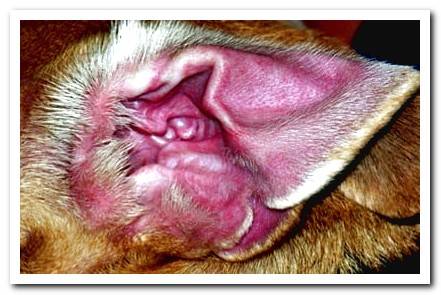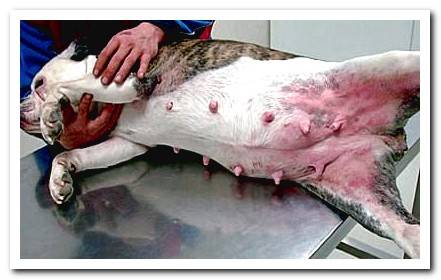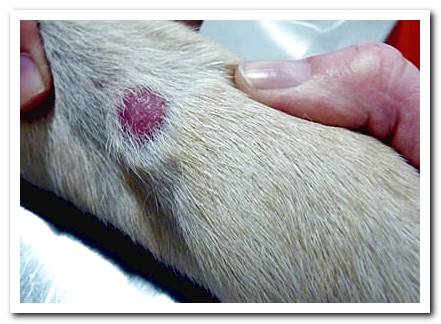
Skin disorders are one of the conditions that we find most frequently in the veterinary practice. There is a wide variety of diseases that can affect the dog’s skin and many manifest in a similar way, complicating its diagnosis.
For this reason, we will try to clarify the causes, symptoms and treatment of the main skin conditions that we can find in a dog.
Index of contents
- 1 Skin infections
- 1.1 Skin infections caused by bacteria
- 1.2 Fungal skin infections
- 1.3 Skin infections caused by parasites
- 2 Allergies
- 3 Skin tumors
- 3.1 Cutaneous histiocytoma
- 3.2 Cutaneous mastocytoma
- 4 Other pathologies
- 4.1 Hyperkeratosis
- 4.2 Canine acne
- 4.3 Systemic diseases
Skin infections
A skin infection it is a skin alteration produced by the invasion of pathogens: bacteria, fungi and / or parasites.
These pathogens are found in the environment or in the dog itself, and if they multiply excessively on our pet’s skin, they can cause injury.
Skin infections caused by bacteria
Skin infections caused by bacteria They are called pyodermas and normally occur when there are skin changes. or underlying diseases that weaken the defenses. Pathogenic bacteria can be “planted” on the dog’s skin by licking or grooming.
Pyoderma is associated with itching, redness of the skin, hair loss, pustules with pus and a bad odor in the affected areas. And they can be localized or generalized.
Treatment is based on topical therapy with disinfectant baths and local antibiotics (lotions, ointments) and / or systemic antibiotics depending on the extent of the process.
Fungal skin infections
Fungal skin infections are called dermatophytosis or ringworm, and are potentially contagious between animals and people.
Fungal infections often develop in dogs that have low defenses or in those that have been in contact with fungally infected animals.
It is characterized by the appearance of circular lesions with hair loss and flaking. Ringworm in dogs is not itchy, at least in the early stages. Over time, these lesions can become infected with bacteria and appear severe itching and redness.
Usually, a treatment with topical antifungal products (lotions, shampoo) is carried out, and in more advanced cases of greater severity an oral antifungal is prescribed.

Skin infections caused by parasites
External parasites that can infect dogs are classified into two groups:
- Macroscopic: they are seen with the naked eye. Fleas, lice and ticks.
- Microscopic: skin scraping is required to view them under a microscope. This group includes scabies-producing mites.
Flea or tick infestation is common in dogs, especially in the hot months. Its treatment and prevention is carried out by applying external dewormers (pipettes or necklaces).

Scabies, however, is not such a common process. The dogs most susceptible to contracting scabies are those who have low defenses or who remain in poor hygienic conditions. There are two main types of scabies:
- Demodectic mange: It is caused by mites that are found naturally on the dog’s skin. The disease occurs when the number of mites multiplies excessively due to a drop in defenses. This scabies is frequent in puppies with immune problems and causes intense itching. It is not considered contagious.
- Sarcoptic mange: It can occur in dogs of any age and often occurs in animals with low defenses or kept in poor hygiene. It is caused by a mite that multiplies rapidly by digging tunnels in the skin, causing the dog to intensely redden the affected areas and become very itchy. It is highly contagious between animals, and people.
The treatment of scabies is carried out by applying topical acaricides (baths, lotions) if it is a localized process, or with systemic acaricides (pipettes, injections) in cases of generalized scabies.
Allergies
In dogs we can differentiate two types of allergies:
- Environmental atopy or allergy: It is a hypersensitivity reaction that occurs due to the contact or inhalation of allergens found in the environment (pollen, plants …)
- Food Allergy: It is an adverse reaction that occurs after ingesting certain foods.
In both types of allergies, the main symptom that we are going to observe is itching. There may also appear redness of the skin, rashes, hair loss, and injuries due to scratching.

In the case of atopias, it is advisable to determine what the dog is allergic to by means of intradermal tests, in order to try to reduce exposure to these allergens and make a vaccine to improve the disease. Symptoms can be controlled with the administration of drugs when necessary (corticosteroids, immunomodulators or antihistamines).
The treatment of food allergies It is somewhat simpler, since there are allergen-free diets for this type of patient.
Skin tumors
Variable-looking formations or masses may appear on the skin and we must rule out that they are tumor lesions. The most common skin tumors in dogs are:
- Cutaneous histiocytoma
- Cutaneous mastocytoma

Cutaneous histiocytoma
It is a benign tumor and is commonly referred to as a “button” tumor, as it presents as a slight round, often alopecal (hairless) skin lift.
Thus, it is an easy tumor to visualize by the owners. Although they are self-limiting growth, their surgical removal is recommended to avoid problems such as secondary infections or friction or lick injuries.
Cutaneous mastocytoma
It is a potentially malignant tumor of highly variable appearance, which can even be confused with other skin lesions or warts. It usually begins as nodules on the skin, but its evolution is very unpredictable and it is common to observe that these masses increase and decrease in size.
The diagnosis is made by puncture of the mass for cytology, and after confirming this pathology, the surgical removal of the
nodules should be performed. Radiation or chemotherapy may be required.
Other pathologies
Hyperkeratosis
Hyperkeratosis is a fairly common skin disease in dogs that consists of excessive production of keratin in the truffle and / or in the pads. This causes a thickening and hardening of the skin that tends to crack, favoring the appearance of secondary infections.
This alteration can be a symptom of systemic diseases such as leishmaniasis, pemphigus foliaceus, or zinc deficiency, but it can also occur spontaneously in healthy dogs (especially older dogs).

For its treatment, if a specific disease can be detected, it should be treated accordingly. If there is no specific cause (idiopathic hyperkeratosis), topical treatment should be applied to improve the lesions with emollient and moisturizing creams. In the event that the cracks become infected, antibiotic treatment should be established.
Canine acne
It is an inflammatory process of the skin that is produced by the irritation of the hair follicles, which favors the proliferation of bacteria. Human acne-like lesions appear (papules and pustules), which are most often located in the area of the chin and lips. It can cause itching and pain.
It is more frequent in puppies and usually resolves spontaneously when they reach adulthood.
Treatment consists of cleaning the affected area with shampoo or disinfecting lotions and topical or oral antibiotic treatment depending on the severity of the process.
Systemic diseases
There are systemic diseases that are not specifically located on the skin, but that produce skin symptoms.
- Hormonal diseases: They are usually associated mainly with hair loss. Some examples are hypothyroidism and Cushing’s syndrome.
- Leishmaniosis: It usually produces skin symptoms such as hair loss around the eyes and ears, peeling, excessive growth of the nails (onychogryposis), nasodigital hyperkeratosis, among others.
As you can see, the variety of skin processes that a dog can undergo is very wide and symptoms are sometimes common among them. Therefore, we should never assume a diagnosis on our own and you should always go to the vet if any alteration is detected in the dog’s skin.
